#littleprinceat2700F
Photo
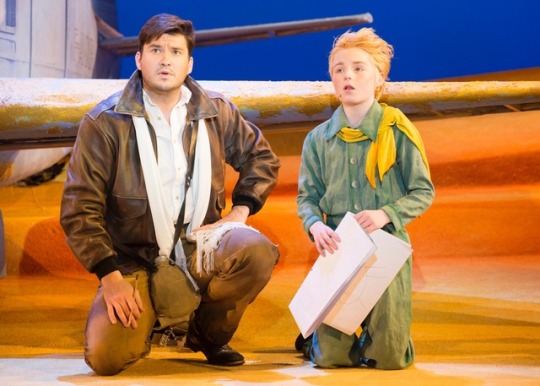
OPERA / 2017-2018
The Little Prince
OPEN REHEARSAL
Washington National Opera
Music by Rachel Portman
Libretto by Nicholas Wright
Based on the book by Antoine de Saint-Exupéry
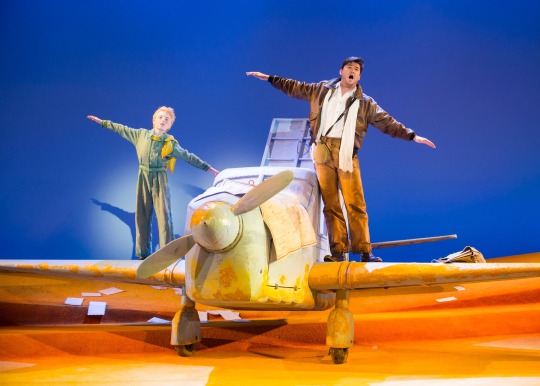
So, What’s Going On?
ACT I
A young pilot introduces himself to the audience. He explains how grown-ups never really understood him and that now, as an adult, he earns a living soaring through the sky. The stars sing to him as he glides through the air, but, despite the pleasant atmosphere, he suddenly loses control of his plane and crashes into the Sahara Desert.
The pilot looks over the damage and begins to try and fix the plane. But just as he grabs his tools, he’s interrupted by a small boy who curiously asks the pilot to draw a sheep. Though confused at first, the pilot comes to know the boy as “the Little Prince,” and, slowly, the prince reveals his unusual story.
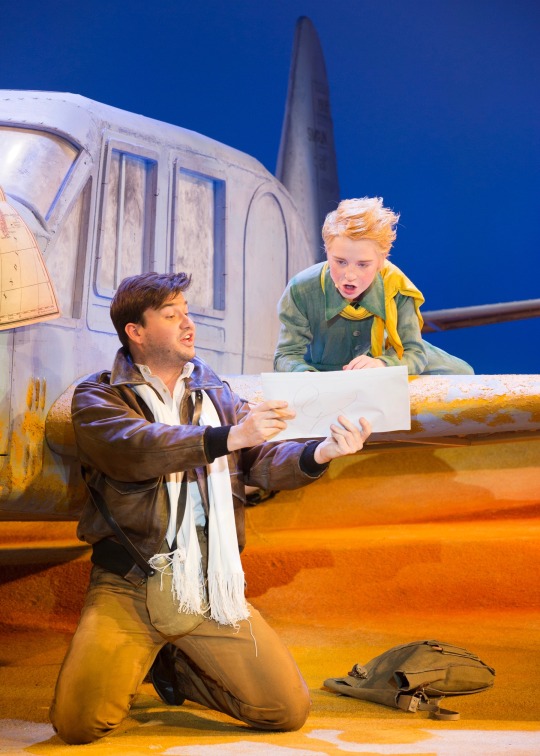
The pilot tries to impress the prince with his drawing skills.
Take a listen…
The pilot describes the Little Prince’s little planet (and its three mini volcanoes) in a film version of the opera from 2004.
vimeo
We learn the prince was once the proud owner of a tiny asteroid, where he cared for a lovely rose whom he adored but who was also very difficult to please. She challenged him to leave his home and gain more wisdom in order to be able to take care of her better, and so… he set out to visit some neighboring planets. During his travels he met several strange adults, including a king, a vain man, a drunkard, a businessman, and a lamplighter. After meeting these men, the Little Prince—not quite satisfied with what he’d discovered so far—decided to journey to planet Earth.
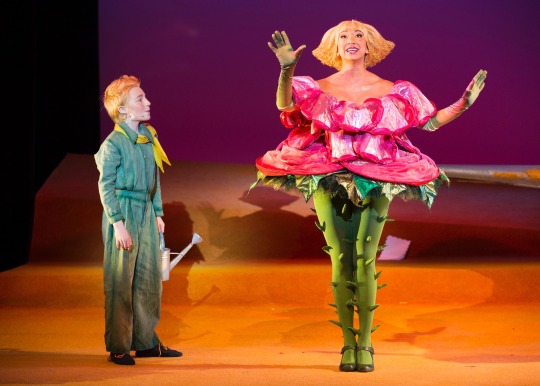
The prince admires his beautiful yet fickle and demanding rose.
ACT II
The prince continues his story while the pilot listens. On Earth, the prince says, he met a slithering snake who claimed that his deadly poison could “ease” all the prince’s worries. The Little Prince then encountered a garden full of roses and cried at the thought that his own rose might merely be one out of a million other common flowers.
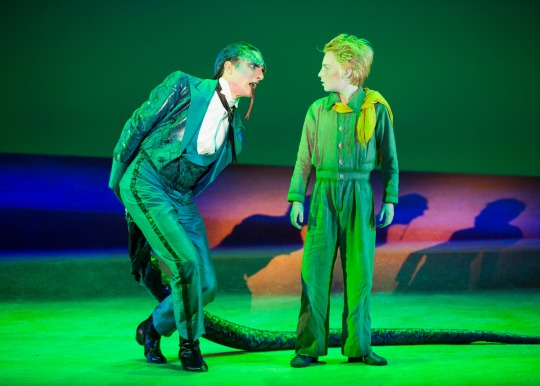
A scheming snake promises to cure the Little Prince’s homesickness.
The prince resumes his tale. Soon after meeting the roses, he adds, he was comforted by a friendly fox. The fox, who begged the prince to tame her and make her his own, gently explained that everything worthwhile is invisible and that such things cannot be touched, but can only be felt with the heart. She also told him that the bonds of love are what make all things—including ordinary flowers— uniquely special.
Take a listen…
The fox asks the Little Prince to “tame” her by becoming her friend.
The pilot then cuts off the prince’s story, saying that the two of them will need water if they are to continue to survive in the desert. Exhausted, they travel to a spot directly beneath the prince’s planet (which sits high in the night sky) and discover a well. As they collect cool water from the crystal-clear well, the pilot realizes his friendly affection for the prince and begins to understand the fox’s message.
Still, the prince longs to return to his rose as he has promised. Will the tired and weary Little Prince make it home? Will the pilot be able to keep the prince’s lessons in his heart if the Little Prince disappears?

The pilot carries the fragile Little Prince across the Sahara in search of a well.
Who’s Who
The Pilot (baritone—a middle-range male voice)
The Little Prince, a visitor from another world (boy soprano—a voice type that applies to young boys who sing in a high range that’s typical of female singers)
The Rose (soprano—the highest female voice)
A Fox (mezzo-soprano—a middle-range female voice)
A Snake (tenor—the highest male voice)
The Voice of the Water (soprano)
The Inhabitants of Nearby Planets
Good to Know
Novelist Antoine de Saint-Exupéry (ahn-TWAN duh san-teg-zu-pey-REE)’s The Little Prince (or Le Petit Prince, in the original French) may have gone down in literary history as a timeless fairytale about life, love, loss, and the power of memory, but it was actually inspired by true events. Sort of. Saint-Exupéry, an accomplished artist and author, was—much like the narrator of his Little Prince story—a trained pilot. Yet despite his skills in the air and his years of experience working as a flying mail carrier and a reconnaissance pilot for the French government during World War II, Saint-Exupéry sadly suffered several plane crashes throughout his career.
One particular crash in 1935 landed him in the Sahara, where he and his co-pilot were left alone (with limited supplies) for several days. Saint-Exupéry witnessed several mirages while out beneath the desert sun and reportedly met with several imaginary creatures he had hallucinated. Years later, while in New York seeking sanctuary from war-torn Europe, Saint-Exupéry refashioned his own desert adventures into a fantastic tale about a lonely pilot whose life is given new meaning when he meets a remarkable little boy from outer space.
Loved by children and grown-ups alike for its simple language, vivid illustrations (also created by Saint-Exupéry) and enduring message of finding joy even in the saddest of times, The Little Prince has provided material for several films and stage works since its original publication in 1943. And when acclaimed film composer Rachel Portman decided to take a break from her successful movie career to create an opera suitable for children, she turned to Saint-Exupéry’s famous tale for inspiration, eventually realizing it was the perfect story for a kid-friendly operatic endeavor.

The fox tells the prince an invaluable secret.
Check This Out…
Children’s choruses, though they make appearances in some of opera’s best-loved works, aren’t used by operatic composers all that often. Why do you think Rachel Portman added a children’s chorus to The Little Prince? What function does the chorus play, if any? Can you come up with other instances in film, TV, literature, or theater where a chorus or group of people is employed in a similar way?
In Saint-Exupéry’s book, the prince has a special admiration for the lamplighter. In the opera, the prince joins this character in song, which is something he rarely does with the other “adults” in the story. Why do you think the lamplighter is given added significance by both Saint-Exupéry and Portman? Why do you feel the composer chose to have these two sing together?
The flute often plays alongside the prince’s voice. Why do you think the composer chose this instrument to accompany the Little Prince so frequently? Does the flute make you think of any particular aspects of the prince’s character?

The prince meets a king who loves to rule but never asks his subjects for anything unreasonable.
Think About This…
What to watch and listen for…
How the musical melodies rise and fall along with the characters’ feelings. (Example: The voice of the well water keeps getting higher and higher as the prince and the pilot enjoy a happy moment.) Does this technique help you sympathize with the characters and their experiences? Can you name other songs you’ve heard that use this same effect?
The overly-powerful and relentless music for the baobab (pronounced BEY-oh-bab) trees. Listen for the low-sounding instruments and the forceful drums that represent these destructive plants. What do the sounds remind you of? Do you think the greedy baobabs represented a specific concept, ideology, or group to Saint-Exupéry, who witnessed World Wars I and II?
How the prince and the pilot occasionally sing in short, choppy bursts with very few instruments, but also sing longer phrases that rise above the entire orchestra. Why do you think the composer uses these different styles? Do the styles remind you of anything? (Hint: Think about what it sounds like when you have a normal conversation vs. when you talk about something that excites you or gives you joy.)

The prince prepares to return “home.”
Take Action: An Invisible Top Ten
Perhaps one of the greatest lessons of The Little Prince is the fox’s mantra: “Anything essential is invisible to the eye.” Both the opera and Saint-Exupéry’s original story invite audiences to take the time to celebrate feelings rather than physical objects and to examine the tiny details that make our favorite people and most memorable experiences so important.
We challenge you to do the same.
Without naming any items that can be seen or touched, make a list of 10 things that inspire you, move you, make you happy, or give you a sense of purpose. Nothing is off limits (these can be moods or events you encounter every day or once-in-a-lifetime occurrences and emotions), but try to come up with thoughts and feelings rather than material gifts or techie gadgets. Your preferred model of smartphone? Leave that off the list. That sense of excitement you get when you’re visiting somewhere new on vacation? That’s more like it.
When you’re finished, share your list with family, friends, and fellow students. Ask them to make their own top ten as well. See if you can collect a bunch of top ten lists from people with a variety of different ages, backgrounds, and life stories. Gather your favorite entries and ask permission to post them on social media platforms like Facebook, Twitter, Snapchat or Instagram with the hashtag #invisibleessentials.
Explore More
Go even deeper with The Little Prince Extras.
–
All photos by Scott Suchman.
–
Major support for WNO is provided by Jacqueline Badger Mars.
David and Alice Rubenstein are the Presenting Underwriters of WNO.
WNO acknowledges the longstanding generosity of Life Chairman Mrs. Eugene B. Casey.
WNO's Presenting Sponsor

The Domingo-Cafritz Young Artist Program is made possible through the generous support of The Morris and Gwendolyn Cafritz Foundation, with additional funding provided by Judy and Billy Cox, Robert and Lynn Downing, Virginia McGehee Friend, Nicole Alfandre Halbreiner, Susan Carmel Lehrman, John & Mary Lee Malcolm, Michael F. and Noémi K. Neidorff and The Centene Charitable Foundation, Mr. and Mrs. Geoffrey P. Pohanka, Dr. Arthur and Mrs. Robin Sagoskin, Mr. Alan J. Savada and Mr. Will Stevenson, Mr. and Mrs. William E. Schuiling, Jr., Dr. and Mrs. Guillermo Schultz, Mr. and Mrs. Michael R. Sonnenreich, Washington National Opera Council, and The Women’s Committee of Washington National Opera.
Additional support for Events for Students is provided by A. James & Alice B. Clark Foundation; the Kimsey Endowment; The Morris and Gwendolyn Cafritz Foundation; Paul M. Angell Family Foundation; and the U.S. Department of Education.
Funding for Access and Accommodation Programs at the Kennedy Center is provided by the U.S. Department of Education.
Major support for educational programs at the Kennedy Center is provided by David and Alice Rubenstein through the Rubenstein Arts Access Program.
Kennedy Center education and related artistic programming is made possible through the generosity of the National Committee for the Performing Arts and the President’s Advisory Committee on the Arts.
© 2017 The John F. Kennedy Center for the Performing Arts
0 notes